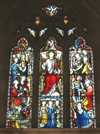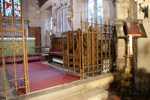For this church:    |
|
 The
Pigot memorial The
Pigot memorial |
Gervase Pigott, the master of Thrumpton Hall, carried out some improvements to Thrumpton church but this has been swept away in later rebuilding. One feature that has remained is the Pigot memorial. This was originally located in the chancel but was moved to the tower in 1870. It was restored back to its original position in the chancel in 1950. The precise date of the monument is uncertain but is believed to be between 1673 and 1695 and its 1870 position can be seen by a change in stone colour in the tower base.
On the 9th May 1673 there was an entry in the Calendar for Treasury Books for rents from “the rectory of Ratcliffe in Thrumpton – £6-13-4”. What this is for is unknown unless this is a trailing charge levied by the crown as a result of the 1606 grant. However, Throsby writing in 1797, records, “in that year both Thrumpton and Kingston were paying small charges” but he was not specific as to how much.
Gervase Pigot the third was known as a wastrel having embezzled the revenues of the grandson of Ratcliffe’s Lady Lucy Grantham. Eventually, he was forced to sell his estates to pay his debts the Hall being acquired by the mortgagee, John Emmerton of London.
 The
east window The
east window |
Some details are known about the church in the 18th century from the writings of two 19th century historians, Godfrey and Stretton. Godfrey repeats Stretton’s visitation record in 1819 and mentions that it had been re-pewed in 1795 when the east window was also renewed. This would be under the direction the Emmerton family.
On the 3rd August 1843 Lucy Elizabeth Jane Wescomb the eldest niece of Emmerton-Wescomb family married George Anson, 8th Lord Byron, forging a connection between Thrumpton and Newstead.
In 1851, Thrumpton had a population of only 133. There was an afternoon service in the church attended by 55 people and another 17 were in the Sunday School. A Wesleyan chapel, opened the previous year, attracted 50 people to its evening service.
In June 1870 Lord and Lady Byron spearheaded preparations for, and the achievement of a faculty to put in hand an extensive rebuilding of the east end on the Nave and the Chancel. Lady Byron, the incumbent the Rev Philip Henry Douglas and a churchwarden William Thomas Norman, as well as “diverse other parishioners”, were signatories to the application. The faculty was issued by the Consistory Court on 3 June 1870.
The 8th Lord Byron died on 18 November 1870 and was buried at Thrumpton, but his widow, Lady Lucy Byron, went ahead with the work under the terms of the faculty. The work was carried out under the direction of George Edmund Street, and the contractor was a Mr Clipsham. The work was completed in December 1871.
 Looking
into the chancel Looking
into the chancel |
A summary of the work undertaken during the restoration is provided by an article in the Nottinghamshire Guardian published in November 1871:
'A great portion of the old church has been pulled down, and new walls of stone have been erected. Instead of being elevated in the gallery, the choristers are placed in their proper position in the chancel, whilst in the place of the pews open seats of the most approved style have been provided. The pulpit, reading desk, and font are entirely new, and the whole of the interior has fitted up after the fashion of the best city churches. It is at the east end of the new building, however, that the greatest improvements are manifested. Over the altar a handsome reredos has been erected, and there is a beautiful piece of alabaster work representing the crucifixion of our Lord, the figures being remarkably distinct and well modelled. The east window is of stained glass representing all the saints, and has been placed there by Lady Byron in memory of her late father and mother, Mr and Mrs. Westcombe.
An organ chamber and vestry were also added on the north side of the chancel. Altogether the rebuilding work cost £3,400 which was raised by subscription.
The Rev Philip Douglas was rector of the parish for 51 years until his death in post in 1914 aged 79. In 1878 he married Lady Byron, and so became the patron of the parish as well as the resident incumbent. It was said of him that
'Mr Douglas belonged to a type of country clergyman which is fast disappearing. A well-read scholar of no mean attainments, an excellent preacher of helpful sermons, a cultured ‘gentleman’ in the best sense of the word ... For more than half a century he went ‘in and out’ amongst his parishioners in the quiet retired riverside village of Thrumpton, with a friendly word and act for old and young, and his unostentatious kindness will long be treasured in their memories.'
His wife, Lady Lucy Byron, died at Thrumpton in 1912 and was buried in the churchyard. On Douglas’s death two years later the patronage passed to the Rev and Hon F E C Byron, who installed himself as vicar!
Thrumpton’s population rose to 167 in 1901 but then fell back to 133 in 1912. In 1912 there were 125 seats in the church, 25 on the roll of the church school, 29 on the roll of the Sunday School, and in the twelve months to September 1912 there had been 15 baptisms and 7 confirmations.
The title was inherited by George Frederick William Byron as the 9th Lord. He died in 1917 and like his predecessors, was buried at Thrumpton. The Byron title passed to a nephew as the 10th Lord. Later the Hall was purchased by a nephew, George Fitzroy Seymour, father of the current owner.
Local historian, Harry Gill, writing in 1924, complained that the church interior was so dark that the memorials could not be read, the lighting being by paraffin lamp. When electric light was installed in Thrumpton Hall the church was fitted out as well.
Little change has taken place to the church since the 19th century. One noted addition is the War Memorial which is very unusual and dates from 1923.
Registers exist from 1679.






